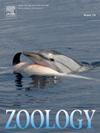Jaw muscle architecture in the greater rhea (Rhea americana): Morphological patterns and postnatal ontogeny in an herbivorous bird
IF 1.6
3区 生物学
Q2 ZOOLOGY
引用次数: 0
Abstract
The jaw muscle architecture is crucial for understanding how muscle morphology influences diet and feeding behavior in birds, yet ontogenetic scaling patterns and their characteristics in herbivorous species remain understudied. This study examines the physiological cross-sectional area (PCSA) and fiber length of the jaw muscles in Rhea americana, an herbivorous bird whose chicks are insectivorous during early stages. The main jaw muscles of 19 Rhea americana specimens across four ontogenetic stages were analyzed, including the depressor mandibulae (a jaw depressor) and the adductor mandibulae externus, pseudotemporalis, and pterygoideus lateralis (primarily jaw adductors). Both architectural parameters showed a negative allometric scaling and only significant differences in PCSA were found between immature ages and between these and adulthood in certain adductor muscles. These variations suggest increasing force demands in adductor muscles as chicks transition from an insectivorous to an herbivorous diet. The lower PCSA in early-staged chicks reflects the reduced force required for insectivory, while the increasing PCSA with age enables force generation needed for detaching plants in adults. In comparison to other avian diets, the herbivory of greater rhea seems to be linked to a lower force-generating capacity in the adductor muscle group. This study contributes to expanding the knowledge on avian jaw musculature by exploring postnatal ontogenetic changes and their potential relationship with dietary shifts while providing morphological data that can serve as a comparative basis for understanding the link between diet and morphology in birds.
美洲大美洲豹的颚肌结构:一种食草鸟类的形态模式和出生后个体发育
颌骨肌肉结构对于理解肌肉形态如何影响鸟类的饮食和摄食行为至关重要,但草食性物种的个体发生尺度模式及其特征仍未得到充分研究。本研究考察了美洲土雉下颚肌肉的生理截面积(PCSA)和纤维长度,美洲土雉是一种草食性鸟类,其雏鸟在早期阶段是食虫的。19日土卫五的主要颚肌美国文物标本在四个发育阶段进行了分析,包括压板mandibulae(下巴压板)和内收肌mandibulae externus, pseudotemporalis, pterygoideus外侧(主要是下巴合并)。两种结构参数均显示负异速缩放,PCSA仅在未成熟年龄和某些内收肌与成年之间存在显著差异。这些变化表明,随着雏鸡从食虫性饮食过渡到食草性饮食,内收肌的力量需求增加。雏鸡早期较低的PCSA反映了捕食力的减少,而随着年龄的增长,PCSA的增加使成虫能够产生分离植物所需的力。与其他鸟类的饮食相比,大rhea的食草性似乎与内收肌群的发力能力较低有关。本研究通过探索鸟类出生后的个体发育变化及其与饮食变化的潜在关系,扩大了对鸟类颌骨肌肉组织的认识,同时提供了形态学数据,为理解鸟类饮食与形态之间的联系提供了比较基础。
本文章由计算机程序翻译,如有差异,请以英文原文为准。
求助全文
约1分钟内获得全文
求助全文
来源期刊

Zoology
生物-动物学
CiteScore
3.90
自引率
0.00%
发文量
37
审稿时长
70 days
期刊介绍:
Zoology is a journal devoted to experimental and comparative animal science. It presents a common forum for all scientists who take an explicitly organism oriented and integrative approach to the study of animal form, function, development and evolution.
The journal invites papers that take a comparative or experimental approach to behavior and neurobiology, functional morphology, evolution and development, ecological physiology, and cell biology. Due to the increasing realization that animals exist only within a partnership with symbionts, Zoology encourages submissions of papers focused on the analysis of holobionts or metaorganisms as associations of the macroscopic host in synergistic interdependence with numerous microbial and eukaryotic species.
The editors and the editorial board are committed to presenting science at its best. The editorial team is regularly adjusting editorial practice to the ever changing field of animal biology.
 求助内容:
求助内容: 应助结果提醒方式:
应助结果提醒方式:


